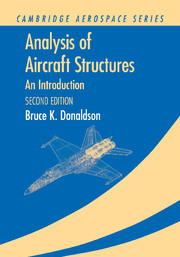Book contents
- Frontmatter
- Contents
- Introduction to the Second Edition
- Introduction to the First Edition
- List of Repeated Engineering Symbols
- Acknowledgments
- Part I The Fundamentals of Structural Analysis
- Part II **Introduction to the Theory of Elasticity**
- Part III Engineering Theory for Straight, Long Beams
- 9 Bending and Extensional Stresses in Beams
- 10 Beam Bending and Extensional Deflections
- 11 Additional Beam Bending Topics
- 12 Uniform Torsion of Beams
- 13 Beam Torsion Approximate Solutions
- Beam Bending and Torsion Review Questions
- 14 Beam Shearing Stresses Due to Shearing Forces
- Part IV Work and Energy Principles
- Part V Energy-Based Numerical Solutions
- Part VI Thin Plate Theory and Structural Stability
- Appendix A Additional Topics
- Appendix B Selected Answers to Exercises
- References
- Index
13 - Beam Torsion Approximate Solutions
from Part III - Engineering Theory for Straight, Long Beams
Published online by Cambridge University Press: 05 June 2012
- Frontmatter
- Contents
- Introduction to the Second Edition
- Introduction to the First Edition
- List of Repeated Engineering Symbols
- Acknowledgments
- Part I The Fundamentals of Structural Analysis
- Part II **Introduction to the Theory of Elasticity**
- Part III Engineering Theory for Straight, Long Beams
- 9 Bending and Extensional Stresses in Beams
- 10 Beam Bending and Extensional Deflections
- 11 Additional Beam Bending Topics
- 12 Uniform Torsion of Beams
- 13 Beam Torsion Approximate Solutions
- Beam Bending and Torsion Review Questions
- 14 Beam Shearing Stresses Due to Shearing Forces
- Part IV Work and Energy Principles
- Part V Energy-Based Numerical Solutions
- Part VI Thin Plate Theory and Structural Stability
- Appendix A Additional Topics
- Appendix B Selected Answers to Exercises
- References
- Index
Summary
Introduction
This chapter examines the standard engineering approaches to beam twisting used with those types of beam cross-sections that are commonly used in vehicular structures. These analytical approaches are far simpler than the theory of elasticity approach of Chapter 12, which requires the satisfaction of a second order partial differential equation and, in general, the satisfaction of a simple boundary condition on a difficult boundary. The basis of these approaches is the division of engineering beam cross-sections into two categories. The first category is that of thin-walled “open cross-sections” and the second category is that of thin walled “closed cross-sections.” A closed cross-section encloses one or more voids. A thin-walled pipe, or better yet, a thin-walled box beam built up from two oppositely facing channel cross-sections (i.e.,] [or []) connected by top and bottom plates so as to produce a rectangular or roughly rectangular interior void, are examples of closed cross-sections. On the other hand, an open cross-section does not have any interior voids. A single channel beam, or an H or I beam are examples of open cross-section beams.
Thin open section beams are generally more efficient than equally strong closed section beams when bending moments and shearing forces are the only significant loadings. That is, in those circumstances, thin open section beams generally weigh less than thin closed section beams. Open cross-section beams also have the advantage that they are easier to connect to other structural components, and inspect for damage.
- Type
- Chapter
- Information
- Analysis of Aircraft StructuresAn Introduction, pp. 403 - 433Publisher: Cambridge University PressPrint publication year: 2008



